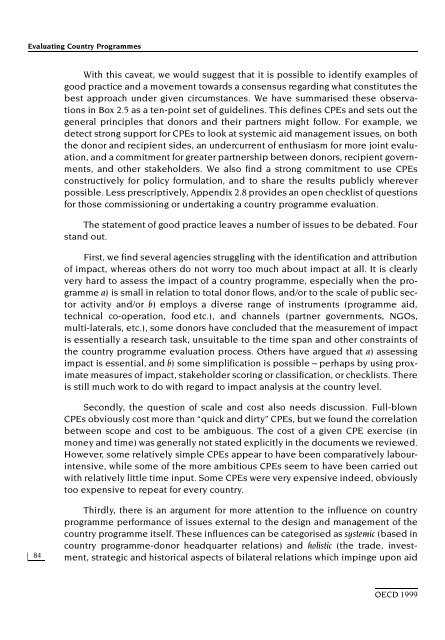Evaluating Country Programmes - OECD Online Bookshop
Evaluating Country Programmes - OECD Online Bookshop
Evaluating Country Programmes - OECD Online Bookshop
You also want an ePaper? Increase the reach of your titles
YUMPU automatically turns print PDFs into web optimized ePapers that Google loves.
<strong>Evaluating</strong> <strong>Country</strong> <strong>Programmes</strong><br />
84<br />
With this caveat, we would suggest that it is possible to identify examples of<br />
good practice and a movement towards a consensus regarding what constitutes the<br />
best approach under given circumstances. We have summarised these observations<br />
in Box 2.5 as a ten-point set of guidelines. This defines CPEs and sets out the<br />
general principles that donors and their partners might follow. For example, we<br />
detect strong support for CPEs to look at systemic aid management issues, on both<br />
the donor and recipient sides, an undercurrent of enthusiasm for more joint evaluation,<br />
and a commitment for greater partnership between donors, recipient governments,<br />
and other stakeholders. We also find a strong commitment to use CPEs<br />
constructively for policy formulation, and to share the results publicly wherever<br />
possible. Less prescriptively, Appendix 2.8 provides an open checklist of questions<br />
for those commissioning or undertaking a country programme evaluation.<br />
The statement of good practice leaves a number of issues to be debated. Four<br />
stand out.<br />
First, we find several agencies struggling with the identification and attribution<br />
of impact, whereas others do not worry too much about impact at all. It is clearly<br />
very hard to assess the impact of a country programme, especially when the programme<br />
a) is small in relation to total donor flows, and/or to the scale of public sector<br />
activity and/or b) employs a diverse range of instruments (programme aid,<br />
technical co-operation, food etc.), and channels (partner governments, NGOs,<br />
multi-laterals, etc.), some donors have concluded that the measurement of impact<br />
is essentially a research task, unsuitable to the time span and other constraints of<br />
the country programme evaluation process. Others have argued that a) assessing<br />
impact is essential, and b) some simplification is possible – perhaps by using proximate<br />
measures of impact, stakeholder scoring or classification, or checklists. There<br />
is still much work to do with regard to impact analysis at the country level.<br />
Secondly, the question of scale and cost also needs discussion. Full-blown<br />
CPEs obviously cost more than “quick and dirty” CPEs, but we found the correlation<br />
between scope and cost to be ambiguous. The cost of a given CPE exercise (in<br />
money and time) was generally not stated explicitly in the documents we reviewed.<br />
However, some relatively simple CPEs appear to have been comparatively labourintensive,<br />
while some of the more ambitious CPEs seem to have been carried out<br />
with relatively little time input. Some CPEs were very expensive indeed, obviously<br />
too expensive to repeat for every country.<br />
Thirdly, there is an argument for more attention to the influence on country<br />
programme performance of issues external to the design and management of the<br />
country programme itself. These influences can be categorised as systemic (based in<br />
country programme-donor headquarter relations) and holistic (the trade, investment,<br />
strategic and historical aspects of bilateral relations which impinge upon aid<br />
<strong>OECD</strong> 1999

















![CQE=U]^\]Z: KAZAKHSTAN - OECD Online Bookshop](https://img.yumpu.com/3915768/1/190x253/cqeuz-kazakhstan-oecd-online-bookshop.jpg?quality=85)